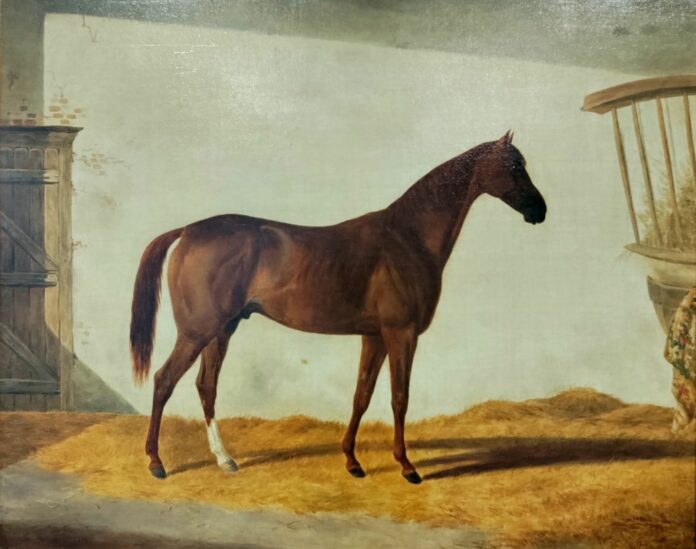SARATOGA SPRINGS, N.Y. — In terms of pedigree, Lecomte had the goods. In terms of performance, he developed the promise of his exquisite bloodlines into a lasting legacy as one of the elite American racehorses of the pre-Civil War era. The impact and greatness of Lecomte were finally recognized with the highest honor in American racing when he was recently inducted into the National Museum of Racing’s Hall of Fame as part of the class of 2024.
Bred in Kentucky by Gen. Thomas Jefferson Wells, Lecomte was a chestnut son of Boston out of the Glencoe mare Reel. The colt was named by Wells in honor of Ambrose Lecomte, a prominent southern horseman and member of the old Louisiana Jockey Club.
Lecomte’s sire, Boston, was elected to the Hall of Fame thanks to winning 40 of 45 starts from 1836 through 1843. Boston also sired Lecomte’s great rival, Hall of Famer Lexington, who proved to be the most influential stallion in American history. Lecomte’s dam, Reel, was one of the top four-mile runners of the early 1840s. She was campaigned by Gen. Wells and won her first seven contests before being forced to retire after suffering an injury in her eighth race. Reel produced 13 foals, including such notables as Fanny Wells, Prioress, Starke, and War Dance.
Reel was by Glencoe, winner of England’s 2,000 Guineas Stakes in 1834 and the Ascot Gold Cup in 1835. Glencoe was one of the earliest stallions imported into the United States and was a top broodmare sire. Numerous great sons of Lexington were out of Glencoe mares, including Hall of Famer Kentucky and the undefeated Asteroid and Norfolk — all three foals of 1861. Glencoe was America’s leading sire eight times between 1847 and 1858.
Lecomte debuted at the Metairie Course in New Orleans on April 5, 1853, in a 2-year-old sweepstakes at mile heats. Although he was a foal of 1850, Lecomte was still considered a 2-year-old. Southern racing rules that were in effect before the Civil War designated ages of horses as calculated from May 1. Lecomte proved to be the precocious sort, winning both mile heats, including a time of 1:45½ in the second heat, the fastest ever raced in America at the time.
Lecomte did not compete again until November. He returned to win at two-mile heats at the Pharsalia Course in Mississippi before winning three races in three weeks back at Metairie to remain undefeated through five starts. His victory on Jan. 6, 1854, was in mile heats against Sallie Ward, considered one of the best mares in the South before the Civil War. Lecomte was finally defeated when he met up with Lexington at Metairie in the Great State Post Stakes in consecutive four-mile heats. The field also included Arrow and Highlander, but neither factored in the outcome. Lexington, owned by Richard Ten Broeck and partners, beat Lecomte by three lengths in the first heat in 8:08¾ and by four lengths in the second in 8:04.
At Metairie a week later, Lecomte and Lexington met in the Jockey Club Purse, again at four-mile heats. Lecomte won the first heat by six lengths in 7:26, more than six seconds faster than the record set by Hall of Famer Fashion a dozen years earlier. With the great Abe Hawkins in the irons, Lecomte won the second heat by four lengths in 7:38¾, which handed Lexington the lone defeat of his career.
Lecomte then won the Association Purse in Mississippi, walked over for a purse two days after that, then returned to New Orleans to win another Jockey Club purse. At this point, early in 1855, Lecomte had won nine of the 10 events he had entered and owned American records for one and four miles. Lecomte and Lexington met once more at Metairie in April 1855. Lecomte appeared to be in poor condition and was easily defeated by Lexington in the first heat. Lexington covered the four-mile distance in race-record time of 7:23¾ (Lexington previously went four miles in 7:19¾ in a timed exhibition). When Lecomte acting lethargic between heats Gen. Wells received permission to withdraw his horse and concede the victory to Lexington.
While Lexington was retired after his record-setting victory, Lecomte returned in the fall to defeat Arrow at four-mile heats, then lost to Arrow three weeks later. He had one more victory, a walkover. Gen. Wells sold Lecomte in April 1856 for $10,000 to old rival Ten Broeck, who sent the horse to Kentucky and bred him to a few mares before shipping him to England to race. The few matings in Kentucky produced Umpire (out of Alice Carneal, Lexington’s dam), winner of five stakes in England; Sherrod, one of the top American runners during the Civil War years; and an unnamed filly who became the third dam of Hall of Fame member Domino.
The Spirit of the Times, one of the leading sources of racing coverage in the 19th century, reported favorably on Lecomte on Nov. 9, 1856: “Lecomte … is in a fine racing form, and well spread throughout his frame, with such an abundance of bone, tendon, and muscle that he would be a useful horse for any purpose. His temper is excellent; he is easily placed in a race, and yet responds promptly to the extent of his ability. He never tears himself and his jockey to pieces by attempting to run away. His action is low, smooth, and easy. His stride is about twenty-three feet, and he gets away from the score like a quarter-horse. He has a constitution of iron, the appetite of a lion, would eat sixteen quarts of feed if it was given to him, and can stand as much work as a team of mules. In a word, he has all the good points and qualities of both sire and dam, without their defects; consequently, he is about as fine a specimen of a Thoroughbred as can be found in this or any other country.”
Lecomte didn’t make it to the races in England in 1856 and experienced interruptions in his training the following year before finally making a start in the Warwick Cup on Sept. 3, 1857. Lecomte was running last in the three-horse field when he pulled up lame. He soon developed a severe case of colic and died on Oct. 7. Lecomte’s overall record was 11-4-1 from 17 starts with earnings of $12,360. The Lecomte Stakes at Fair Grounds Race Course in New Orleans was inaugurated in his honor in 1943.
Originally Published: August 13, 2024 at 2:11 p.m.
Source link : https://www.saratogian.com/2024/08/13/horse-racing-the-legend-of-lecomte/
Author :
Publish date : 2024-08-13 18:11:53
Copyright for syndicated content belongs to the linked Source.





















































